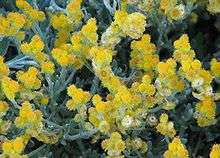Chrysocephalum apiculatum
| Chrysocephalum apiculatum | |
|---|---|
 | |
| Scientific classification | |
| Kingdom: | Plantae |
| (unranked): | Angiosperms |
| (unranked): | Eudicots |
| (unranked): | Asterids |
| Order: | Asterales |
| Family: | Asteraceae |
| Genus: | Chrysocephalum |
| Species: | C. apiculatum |
| Binomial name | |
| Chrysocephalum apiculatum | |
| Synonyms[1] | |
| |
Chrysocephalum apiculatum, known by the common names common everlasting and yellow buttons, is a perennial herb native to southern Australia. It is a member of the Asteraceae, the daisy family. It grows in sunny locations on light, well-drained soil in grassy areas. It is an important food plant for the Australian painted lady (Vanessa kershawi), a butterfly.
The name "everlasting" was inspired by its use as a long-lasting cut flower. It is increasing in popularity in Australia as a cottage garden plant, but is still not well known.[2]
The common everlasting grows to around 40 centimeters high, with spreading horizontal stems that turn upwards as they get longer. The elongated silvery grey leaves clasp tightly to the stems and are covered in fine, silky hairs. The flower heads are yellow in color and spherical in shape, around 1 centimeter in diameter each, and often borne in clusters.[3] The florets are minute. Like many daisies, it has seeds which are gradually dispersed on the wind. The seed germinates readily, but has a short viable life.
References
| Wikimedia Commons has media related to Chrysocephalum apiculatum. |
- ↑ "The Plant List: A Working List of All Plant Species". Retrieved 20 January 2015.
- ↑ "The Native Plants of Adelaide". Department for Environment and Heritage. Archived from the original on 15 March 2011. Retrieved 21 March 2011.
- ↑ Plants of the Adelaide Plains and Hills. Library of South Australia. Accessed 21 March 2011.